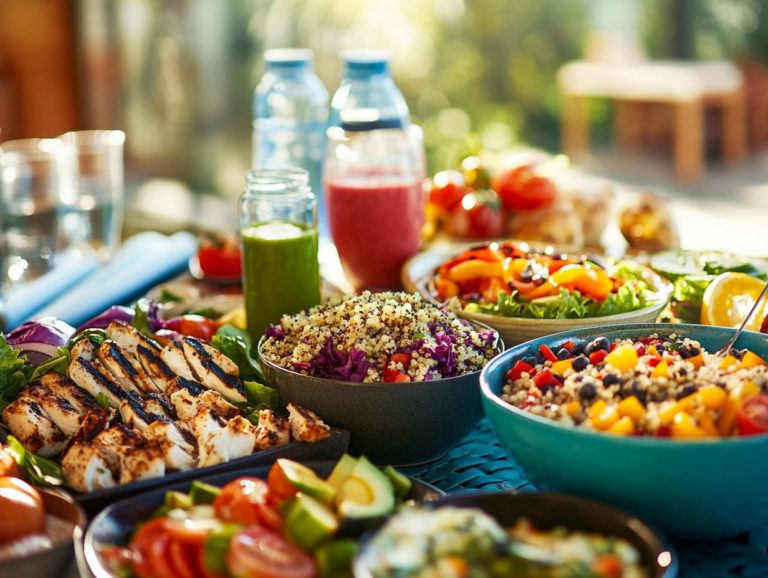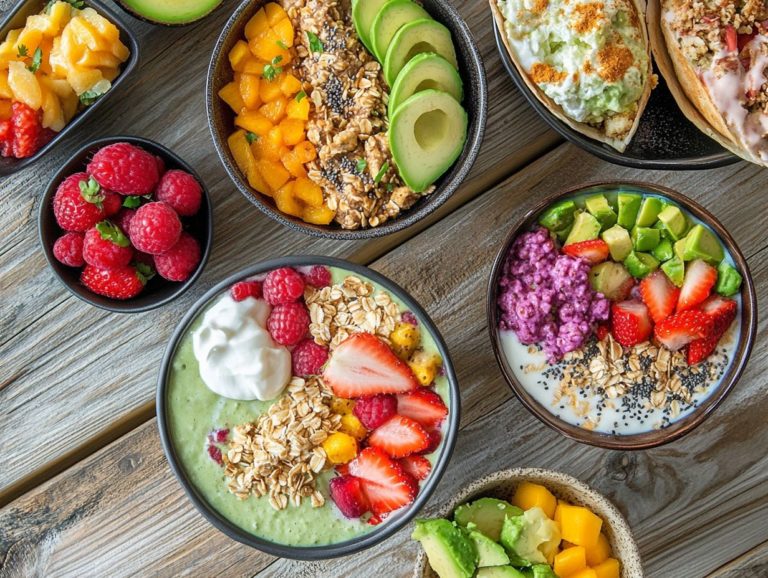Nutrition for Celiac Disease: Safe Eating
Celiac disease affects millions. It requires major dietary changes that can lead to nutritional challenges.
This article delves into celiac disease and underscores its effects on nutrition. It arms you with crucial insights for grocery shopping, meal planning, and enjoying safe dining experiences.
You ll learn how to identify gluten-free foods, decipher labels, and tackle any nutritional deficiencies that may arise. We offer practical tips and sample meal ideas that cater specifically to your needs.
Whether you re newly diagnosed or have been managing this condition for years, you’ll discover valuable insights that will empower you to thrive while following a celiac diet.
Contents
- Key Takeaways:
- Understanding Celiac Disease and Its Nutritional Impacts
- Grocery Shopping for a Celiac Diet
- Meal Planning for a Celiac Diet
- Supplementing a Celiac Diet
- Staying Safe While Dining Out
- Frequently Asked Questions
- What is celiac disease and how does it impact my diet?
- What are some gluten-free alternatives to common foods?
- Which nutrients should I pay attention to in my diet with celiac disease?
- How can I make sure I am eating safely when dining out?
- Are there any hidden sources of gluten I should be aware of?
- How can I ensure I am getting all the necessary nutrients on a gluten-free diet?
Key Takeaways:
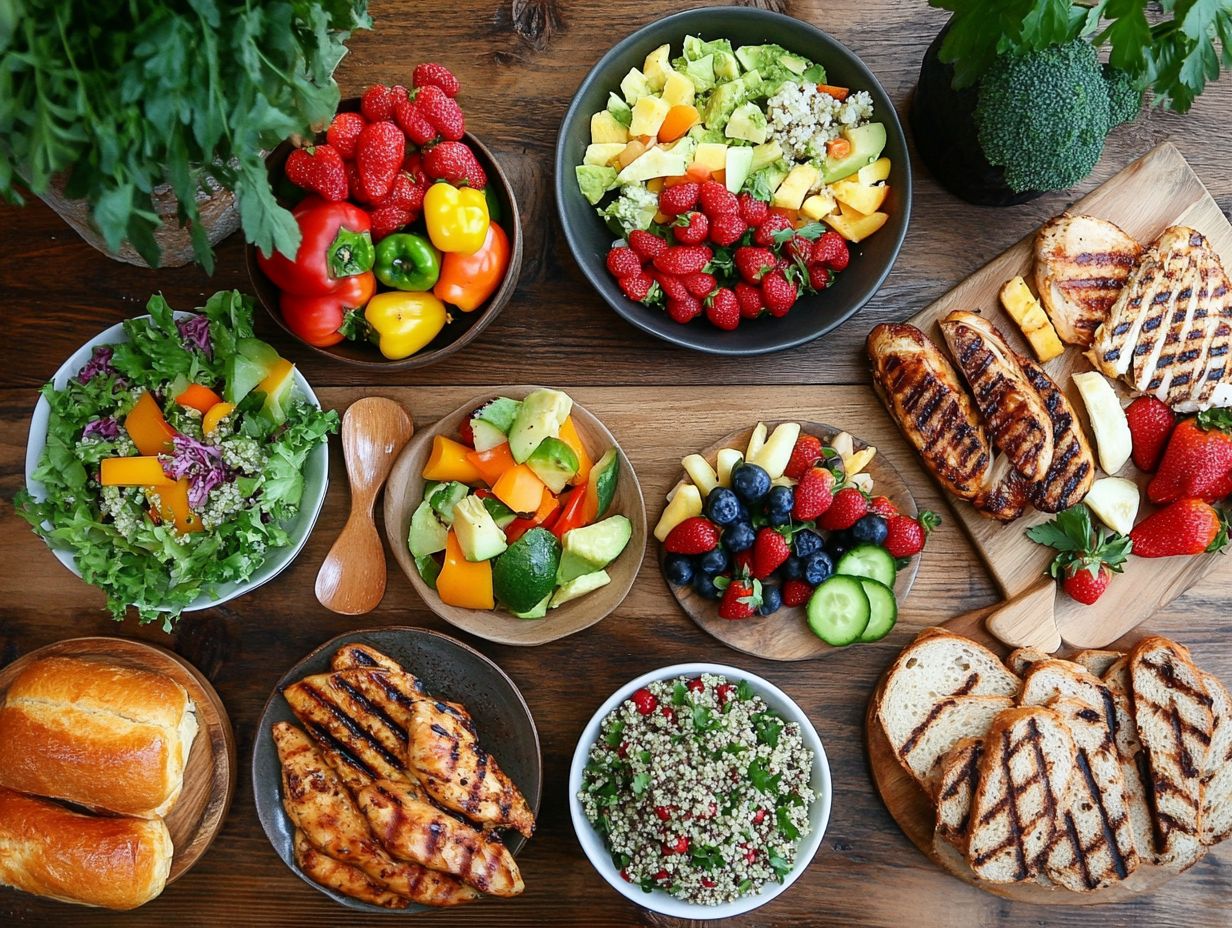
- Beware! Celiac disease can cause nutritional gaps. Plan your meals carefully.
- When grocery shopping, read labels and identify gluten-free foods to avoid cross-contamination. This maintains a safe and healthy celiac diet.
- Dining out can be challenging. Communicate with restaurant staff and follow tips to avoid gluten in social settings for safe eating.
Understanding Celiac Disease and Its Nutritional Impacts
Celiac disease is a serious autoimmune condition. It impacts the small intestine and is triggered by gluten, commonly found in wheat, barley, and rye. If left unmanaged, this condition can lead to significant nutritional deficiencies and various health complications.
Adopting a strict gluten-free diet is essential. It requires careful consideration of multiple factors. Engaging with health professionals for guidance and participating in support groups can enhance your ability to maintain balanced nutrient absorption and cultivate an overall healthy lifestyle.
What is Celiac Disease?
Celiac disease is an autoimmune disorder. It triggers an adverse reaction to gluten a protein found in wheat, barley, and rye leading to inflammation in your small intestine.
When you consume gluten, your immune system mistakenly sees it as a threat. This triggers a misguided inflammatory response that damages your intestinal lining. It disrupts nutrient absorption, resulting in various gastrointestinal symptoms and broader systemic issues.
To manage this condition effectively, you must adhere to strict dietary guidelines. Eliminate all sources of gluten from your diet to avoid both immediate discomfort and long-term complications, such as malnutrition or a heightened risk of other autoimmune disorders. This dietary vigilance relieves symptoms and fortifies your overall health and well-being.
Nutritional Deficiencies and Challenges
Individuals with celiac disease often grapple with nutritional deficiencies due to poor absorption of essential nutrients. This malabsorption can lead to conditions like osteoporosis and iron deficiency, along with dermatitis herpetiformis, a skin manifestation of the disease.
These challenges are intensified by the necessity of a strict gluten-free diet, which can limit your food choices. This may unintentionally result in an inadequate intake of vital vitamins and minerals. Among these, vitamin D and calcium are particularly critical. Deficiencies in these nutrients can impact your bone health, increasing susceptibility to fractures and other complications.
The repercussions of malnutrition extend beyond physical health. They can influence your energy levels, mood, and overall quality of life. Therefore, regularly monitor your nutrient levels to maintain a balanced diet that caters to your unique health needs.
Grocery Shopping for a Celiac Diet
Navigating grocery shopping with a celiac diet requires awareness of gluten-free foods and a solid grasp of reading gluten labels. Many processed items may unknowingly harbor gluten, making it crucial for you to make informed dietary choices while you shop.
This vigilance protects your health and helps you enjoy a varied and satisfying diet.
Identifying Gluten-Free Foods
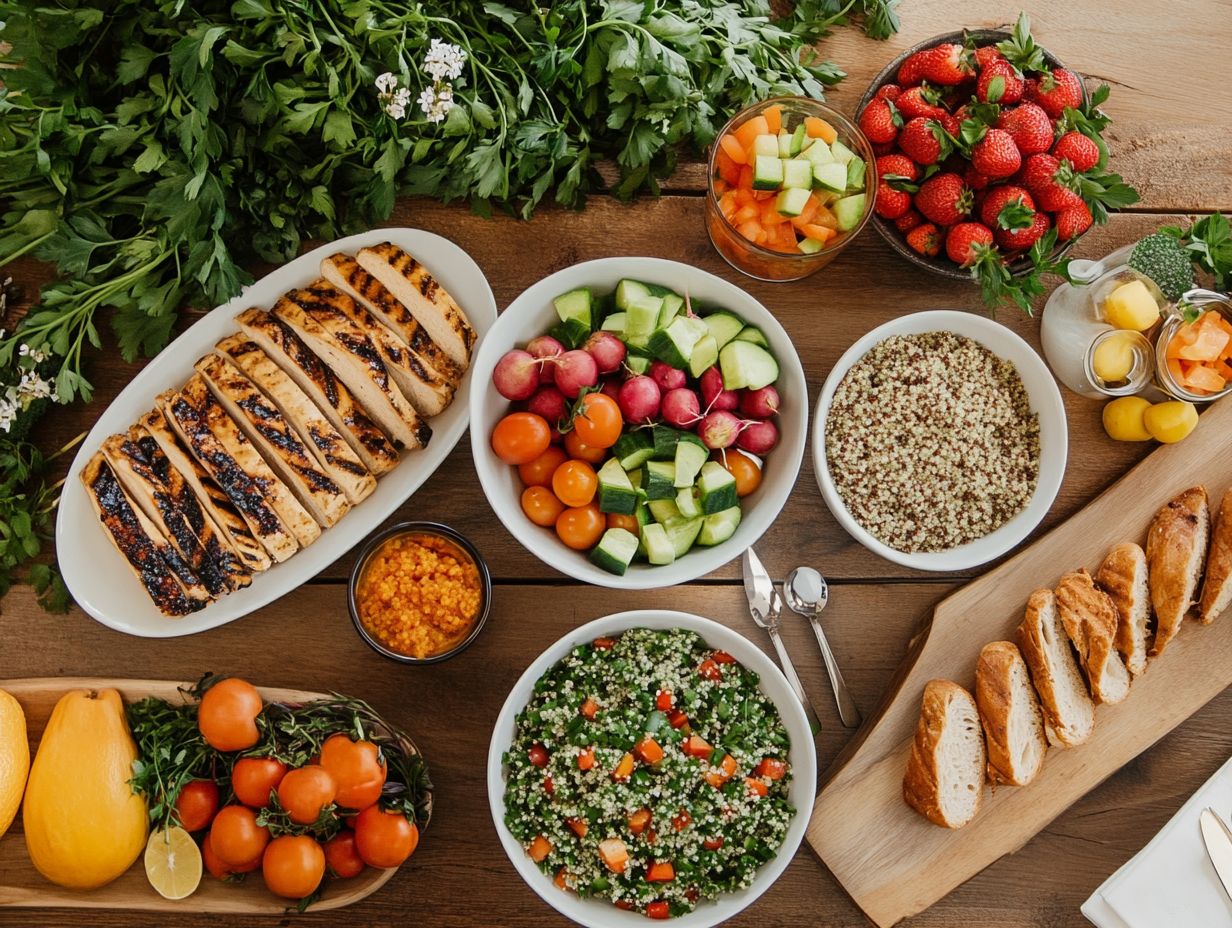
Identifying gluten-free foods starts with a keen understanding of ingredient lists. You also need to recognize certified gluten-free labels to make safe choices if you have gluten sensitivity or celiac disease.
To navigate this process easily, familiarize yourself with resources such as gluten-free apps that allow you to scan barcodes for quick product verification while shopping. Consulting reputable websites or joining support groups focused on gluten-free living can also offer invaluable insights into safe brands and hidden sources of gluten.
Keeping a vigilant eye on cross-contact during meal preparation is essential. Cross-contact occurs when gluten-free foods come into contact with gluten-containing foods. Even the tiniest traces of gluten can trigger unwelcome symptoms. Using dedicated kitchen tools, like separate cutting boards and utensils, further minimizes this risk, creating a safer and more enjoyable culinary experience for you.
Reading Labels and Avoiding Cross-Contamination
Reading labels on food packages is vital for anyone with celiac disease. It enables you to identify gluten-containing ingredients and avoid cross-contact as you navigate dietary changes.
Understanding the key components of the nutrition facts and ingredients lists is essential in this journey. When you examine labels, be on the lookout for terms like wheat, barley, and rye common culprits when it comes to gluten. Pay close attention to phrases such as “may contain” or “produced in a facility that processes gluten”, as these warnings signal potential cross-contact.
To minimize risk further, think about using special cooking tools just for gluten-free meals. Being aware of brand certifications and choosing products clearly labeled as gluten-free can offer you added peace of mind while shopping.
Meal Planning for a Celiac Diet
Meal planning for a celiac diet requires you to maintain balanced nutritional needs while strictly adhering to a gluten-free lifestyle. It s vital to stick to a gluten-free diet to avoid serious health issues, but with the right sample meal ideas and effective dietary strategies, it can be a rewarding experience.
Balancing Nutritional Needs
Balancing your nutritional needs on a gluten-free diet is essential, especially if you have celiac disease. Seeking guidance from a registered dietitian can help you ensure that all necessary nutrients find their way into your meals.
A well-rounded gluten-free diet must tackle the potential gaps in nutrients that are commonly found in gluten-containing grains, such as fiber, iron, and B vitamins. You can achieve this balance by incorporating a variety of naturally gluten-free foods, including fruits, vegetables, legumes, nuts, and whole grains like quinoa and brown rice.
It s also important to pay attention to fortified products to avoid deficiencies. A registered dietitian can offer invaluable support by crafting personalized meal plans tailored to your preferences and nutritional needs, enabling you to thrive on this diet without feeling deprived.
Sample Meal Ideas and Recipes
Sample meal ideas and recipes are truly invaluable for anyone navigating a gluten-free diet. They offer you creative and healthy options that align perfectly with the dietary changes necessary for managing celiac disease.
These recipes can elevate your meal times by introducing a symphony of flavors and textures that you might otherwise overlook. By incorporating a variety of fruits, vegetables, proteins, and whole grains, you ensure a balanced intake of nutrients and keep the process of meal planning fresh and exciting.
Imagine whipping up a quinoa salad bursting with seasonal vegetables or savoring a robust lentil soup enriched with kale and aromatic spices. Breakfast can transform into a delightful experience with oatmeal topped with fresh berries or a vibrant smoothie made with almond milk and spinach.
By exploring a diverse array of recipes, you can relish delicious meals while prioritizing your health and wellness.
Supplementing a Celiac Diet
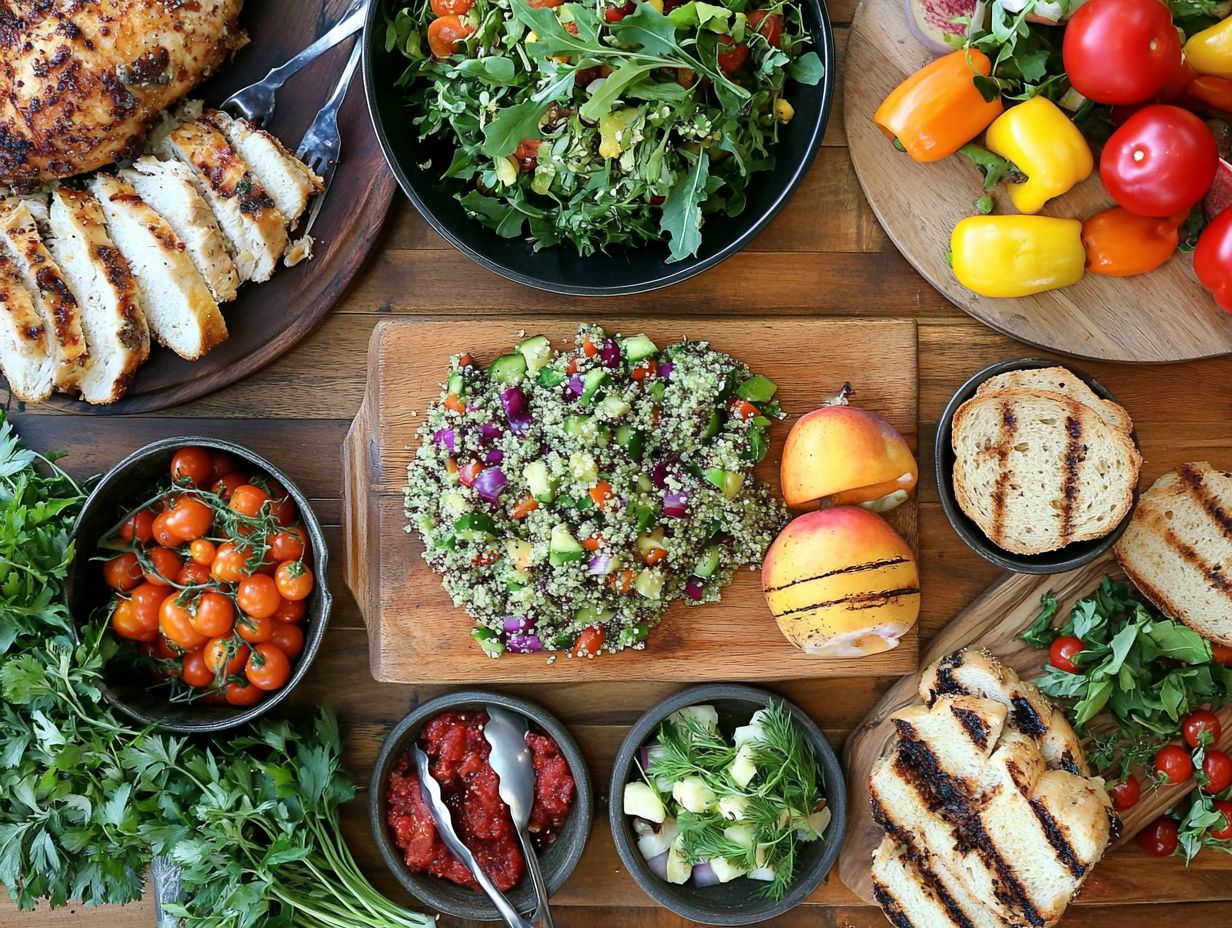
You may find that Supplementing a celiac diet is essential to tackle common nutritional deficiencies, such as low vitamin D, calcium, and iron levels. By doing so, you can ensure that you maintain optimal health while fully committing to a gluten-free lifestyle.
Recommended Supplements
Recommended supplements for individuals with celiac disease typically include vitamin D, calcium, and iron to address common deficiencies stemming from malabsorption.
Taking vitamin D is crucial for enhancing your bone health. Many with celiac disease struggle to absorb nutrients effectively. Calcium supplements are equally important, as they fortify your bone strength and compensate for the potential lack of fortified foods in a gluten-free diet.
Iron is vital for restoring your energy levels since fatigue often accompanies iron-deficiency anemia in those affected. B vitamins like B12 and folate boost energy and brain function. Furthermore, omega-3 fatty acids promote heart health and reduce inflammation, making them essential additions to your supplement regimen.
Staying Safe While Dining Out
When dining out with celiac disease, it’s crucial to communicate effectively with restaurant staff. By doing so and implementing thoughtful strategies, you can confidently navigate social settings and ensure your meal is both safe and enjoyable.
Communicating with Restaurant Staff
Effectively communicating with restaurant staff about gluten sensitivity is essential. This paves the way for clear dietary adjustments and a safe dining experience.
Approach the conversation confidently. Clearly explain your dietary needs for an open dialogue. It helps to ask open-ended questions about how the kitchen manages gluten-free options. This informs you and allows the staff to share their practices, creating a collaborative environment.
Don’t forget to inquire about cross-contamination risks when gluten-free food comes into contact with gluten, which can be harmful and emphasize the importance of proper food preparation methods. By taking this proactive stance, you ensure that your meal is both enjoyable and safe.
Tips for Avoiding Gluten in Social Settings
Navigating social settings while avoiding gluten can be challenging for those with celiac disease. It requires proactive planning and clear communication to ensure your dietary needs are respected at gatherings and events.
Take the initiative to improve your experience. When you receive an invitation, chat with the host about your dietary restrictions well ahead of time. This ensures they fully grasp your needs. Consider bringing along a delicious gluten-free dish to share; not only does this give you something safe to enjoy, but it also showcases that gluten-free options can be delightful.
Furthermore, educating your friends and family about the gluten-free lifestyle is crucial. Sharing simple, accessible resources can cultivate understanding and support, transforming social situations from daunting to delightful.
Frequently Asked Questions

What is celiac disease and how does it impact my diet?
Celiac disease is an autoimmune disorder triggered by gluten that damages the small intestine. This damage can lead to difficulty absorbing essential nutrients, making a gluten-free diet crucial for managing celiac disease.
What are some gluten-free alternatives to common foods?
There are many gluten-free alternatives to foods that typically contain gluten. For example, use quinoa or gluten-free oats instead of wheat-based grains. Choose gluten-free flours for baking, and always read labels and check for gluten-free certification before purchasing any products.
Which nutrients should I pay attention to in my diet with celiac disease?
The most important nutrients to monitor in your diet with celiac disease are iron, calcium, vitamin D, and B vitamins. These nutrients are commonly found in gluten-containing foods, so it’s essential to ensure you are getting enough from gluten-free sources or supplements.
How can I make sure I am eating safely when dining out?
When you dine out, tell the waitstaff about your dietary restrictions. Always ask about gluten-free options!
Research the restaurant’s menu beforehand or call to check gluten-free choices.
To avoid cross-contamination, request clean utensils and a separate cooking area.
Yes, several hidden sources of gluten exist for those with celiac disease.
Keep an eye out for soy sauce, bouillon cubes, and modified food starch. Always read labels carefully!
Learn about alternative names for gluten-containing ingredients.
How can I ensure I am getting all the necessary nutrients on a gluten-free diet?
A gluten-free diet can make getting nutrients tricky. However, with planning, you can manage it!
Incorporate a variety of fruits, vegetables, proteins, and gluten-free grains.
Consider working with a registered dietitian to meet your nutrient needs.


